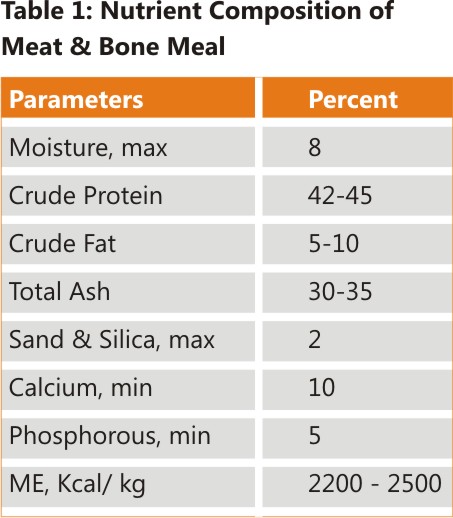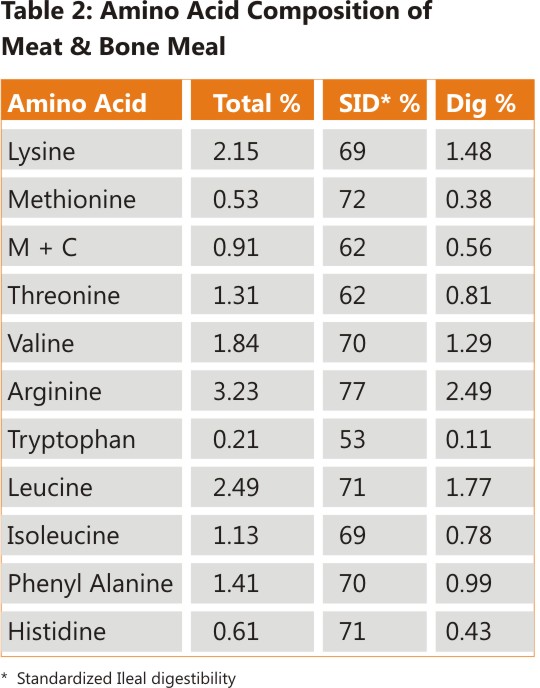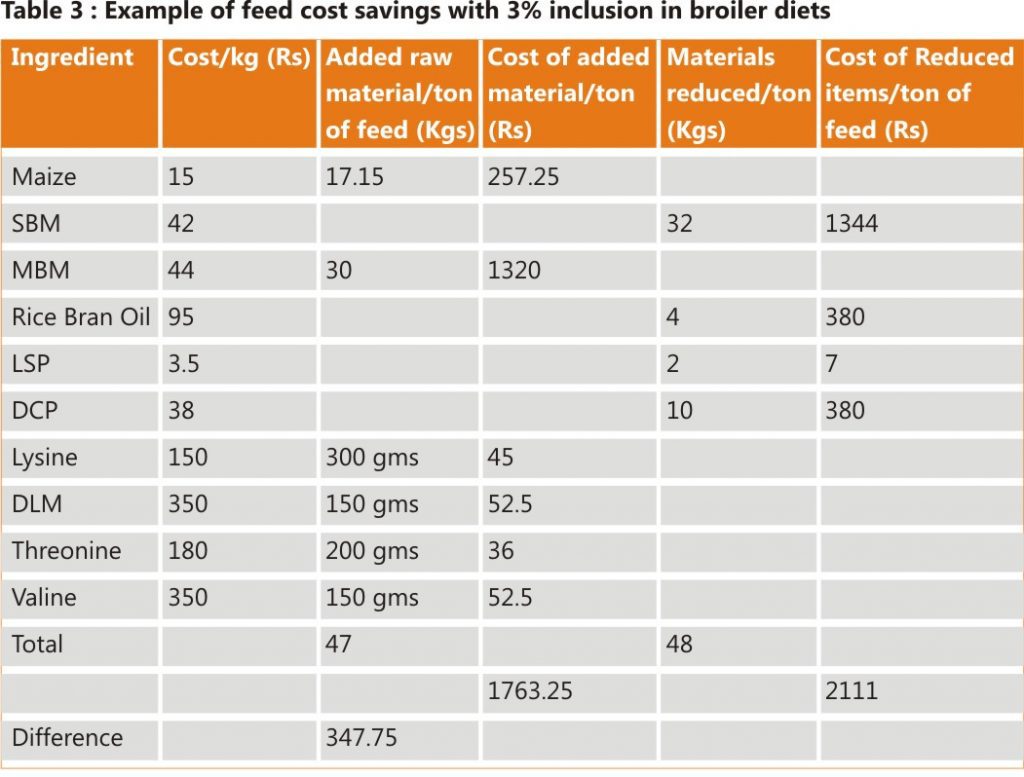

India is the largest exporter of buffalo meat in the world with the highest population of buffaloes which accounts for about 58% of the global buffalo population. As per 2019 census, buffalo population in India is 109 million. In the year 2020, about 34.5 million cattle & buffaloes have been slaughtered for meat production in the country whereas Meat and Bone Meal (MBM), the by-product is globally used as an alternative protein source in Poultry & Aqua feeds.






In poultry feed formulations, soybean meal is used as the major source of protein and amino acids. Whenever the prices of soybean meal are higher, nutritionists have the option of using alternative protein sources like Rapeseed meal, Groundnut doc, Cottonseed meal, Sesame doc, Maize gluten, DDGS, Meat & bone meal (MBM), etc. Among all these, MBM is a unique ingredient that contains good quality protein as well as a rich source of major minerals like calcium & phosphorous. While protein serves as building blocks of the body with a rich amino acid profile the minerals like calcium and phosphorous are necessary for bone growth & strength. It is also rich in total fat which is a good source of Metabolizable Energy (ME). The ME levels vary from 2200-2400 Kcal/kg depending on the quality. Not only this, the inclusion of MBM in poultry diets results in a substantial reduction of feed cost. An example of cost reduction by reformulating is given in table 3.


However, one has to be very cautious while using MBM with regards to bacterial contamination. Properly sterilized MBM should be free from salmonella, clostridia, and E coli. The total bacterial count should be less than 10*103 CFU per gram of the sample. The MBM inclusion allows nutritionists to reduce DCP/MCP as a phosphorous source which reduces the feed costs substantially. The inclusion levels may vary from 2 to 5% depending on the type of feeds. It is generally used at a higher level in layer feeds and a slightly lower level in broiler feeds. While it is not recommended in breeder feeds because of the risk of bacterial contamination. The level of inclusion is decided based on the quality of MBM, its price, availability & the type of feeds. It is recommended to prefer the material from a reliable source like a Meat Processing Company wherein the material (inedible parts) will be cooked & rendered immediately after the portioning of the meat. Such material will be generally fresh and free from spoilage and bacterial contamination. As mentioned earlier, while using MBM one should consider replacing soybean meal as well as DCP/MCP. About 3% inclusion of MBM can give the same average of P as 1% DCP or 0.75% MCP. The reformulations replacing soybean meal & DCP with MBM is shown in the table 3 with illustrations of cost savings per ton considering prevailing raw material prices. Net savings per ton maintaining the same nutritive value is about Rs 350 per ton of feed or 35 Paise per Kg Conclusion: MBM is a good alternative protein source that also contains a good amount of phosphorous. The inclusion of MBM results in substantial cost savings in poultry diets replacing by soyabean meal and DCP when the material is procured from a reputed & reliable source which is free from bacterial contamination. by Dr. S.S. Pattabhirama, Nanda Group


India is the largest exporter of buffalo meat in the world with the highest population of buffaloes which accounts for about 58% of the global buffalo population. As per 2019 census, buffalo population in India is 109 million. In the year 2020, about 34.5 million cattle & buffaloes have been slaughtered for meat production in the country whereas Meat and Bone Meal (MBM), the by-product is globally used as an alternative protein source in Poultry & Aqua feeds.






In poultry feed formulations, soybean meal is used as the major source of protein and amino acids. Whenever the prices of soybean meal are higher, nutritionists have the option of using alternative protein sources like Rapeseed meal, Groundnut doc, Cottonseed meal, Sesame doc, Maize gluten, DDGS, Meat & bone meal (MBM), etc. Among all these, MBM is a unique ingredient that contains good quality protein as well as a rich source of major minerals like calcium & phosphorous. While protein serves as building blocks of the body with a rich amino acid profile the minerals like calcium and phosphorous are necessary for bone growth & strength. It is also rich in total fat which is a good source of Metabolizable Energy (ME). The ME levels vary from 2200-2400 Kcal/kg depending on the quality. Not only this, the inclusion of MBM in poultry diets results in a substantial reduction of feed cost. An example of cost reduction by reformulating is given in table 3.


However, one has to be very cautious while using MBM with regards to bacterial contamination. Properly sterilized MBM should be free from salmonella, clostridia, and E coli. The total bacterial count should be less than 10*103 CFU per gram of the sample. The MBM inclusion allows nutritionists to reduce DCP/MCP as a phosphorous source which reduces the feed costs substantially. The inclusion levels may vary from 2 to 5% depending on the type of feeds. It is generally used at a higher level in layer feeds and a slightly lower level in broiler feeds. While it is not recommended in breeder feeds because of the risk of bacterial contamination. The level of inclusion is decided based on the quality of MBM, its price, availability & the type of feeds. It is recommended to prefer the material from a reliable source like a Meat Processing Company wherein the material (inedible parts) will be cooked & rendered immediately after the portioning of the meat. Such material will be generally fresh and free from spoilage and bacterial contamination. As mentioned earlier, while using MBM one should consider replacing soybean meal as well as DCP/MCP. About 3% inclusion of MBM can give the same average of P as 1% DCP or 0.75% MCP. The reformulations replacing soybean meal & DCP with MBM is shown in the table 3 with illustrations of cost savings per ton considering prevailing raw material prices. Net savings per ton maintaining the same nutritive value is about Rs 350 per ton of feed or 35 Paise per Kg Conclusion: MBM is a good alternative protein source that also contains a good amount of phosphorous. The inclusion of MBM results in substantial cost savings in poultry diets replacing by soyabean meal and DCP when the material is procured from a reputed & reliable source which is free from bacterial contamination. by Dr. S.S. Pattabhirama, Nanda Group













